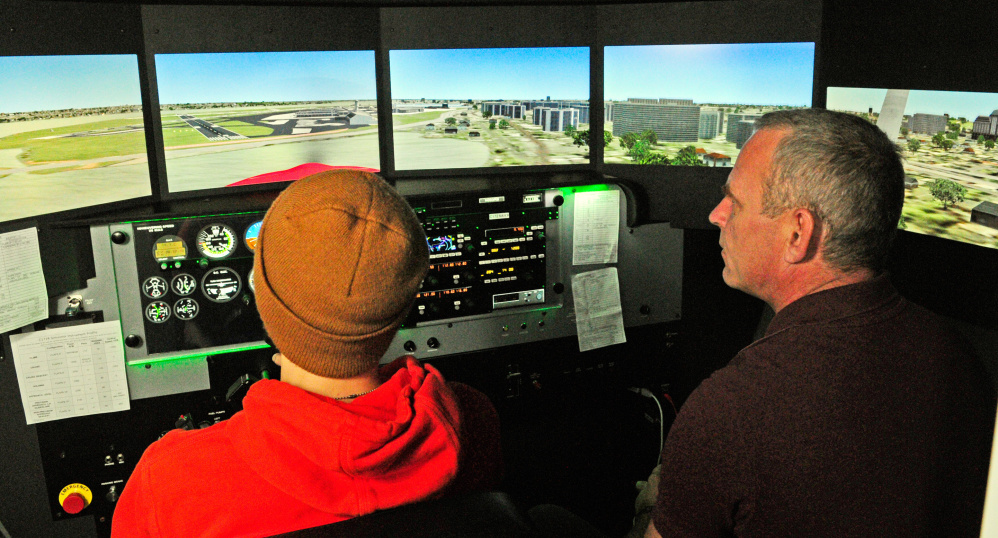AUGUSTA — Friday was a rough day for the virtual Cessna 172 airplane.
While it had numerous safe takeoffs and landings, it also got going so fast its wings fell off, was spun into barrel rolls and forced to fly upside down. It was flown up at such an extreme angle it stalled and plummeted back to earth and had unfortunate, if intentional, collisions with substantial buildings and bridges.
Thankfully the flights by Maranacook Community High School students took place on the University of Maine at Augusta’s flight simulator, not an actual plane. So there was no damage, injury or loss of life. And no crashes that couldn’t be fixed with a quick reboot of the computerized, $100,000 training device.
“I flew too fast and my wings fell off,” student Drew Davis said after his roughly 15-minute stint in the simulated cockpit of the plane. “It was harder than I thought it would be. But once I started, I got the hang of it. It’s weird, feeling it moving around like that.”
The simulator moved more than usual while Davis successfully performed a 360-degree roll, then flew the plane upside down, forcing its control stick to remain in a forward position.
Greg Jolda, aviation program coordinator for UMA, explained some of the dynamics of the science at play, noting planes are designed to fly right side up, so it takes a firm hand to keep them flying upside down.
About 15 Maranacook students were at UMA Friday as part of an engineering class project focused on flying. Students in the semester-long engineering class, a new science class offered for the first time this year, according to teacher Jean Roesner, chose the project topic themselves. They’ve been studying aviation in class and are also building a remote control airplane they expect will be ready to fly in a couple of weeks.
Flight instructor David Russo, a former test pilot and commercial airline pilot, guided students in the simulator. He warned them taking off would be a lot easier than landing. Most students appeared to land successfully. After that, they had some leeway and were allowed to find out what it’s like to crash.
“As long as you complete your takeoff and landing, then you can do whatever you want,” Russo said. “You can’t really break the simulator. If you crash, you just reset.”
Which several did as they flew on the simulator out of a virtual Ronald Reagan Washington National Airport with at least one student crashing into the Washington Monument.
Student Tanner Evans had a successful first takeoff and landing, but on his second landing attempt, the aircraft nosed into the tarmac and crashed, the simulator’s six screens going black.
Student Ryan Roy said flying was harder than he expected. But he enjoyed it.
“It’s cool,” Roy said after his stint on the simulator. “I landed it kind of rough, but it didn’t blow up, so I guess it was fine.”
Students wrote a successful grant application which brought in $500 from the Maranacook Education Foundation and National Honor Society to help fund the cost of building their remote control plane.
Friday they each had a turn at the simulator and had a chance to fly one of several remote control planes on loan to them outside on a UMA athletic field under the direction of remote control plane instructors. The instructors had redundant remote controls so they could take over control of the planes when students began to fly off course or otherwise begin to lose control.
Student Hannah Woodford said flying the remote control planes was a bit scary. She said she’s not likely to become a pilot.
“It was scary. I’m not very good. I heard ‘I’ll take control now’ a lot,” she said, laughing.
Volunteer instructor Eric Guilmet of Readfield encouraged the student-pilots as they took the controls of the remote- control aircraft, reminding them to try to be smooth with the controls to avoid a twitchy flight. The licensed pilot and remote-control aviation instructor offered advice and, when necessary, took control of the aircraft, including on landings and takeoffs.
Guilmet, who has been flying remote-control airplanes since he was 13 years old, said the students could land and take off themselves with a bit more instruction.
He and Jolda, who are both involved with the Kennebec Valley Model Aviators Club, said good instruction is key to anyone first learning to fly, even if what they’re flying is a remote-control and not full-size aircraft.
Send questions/comments to the editors.




Success. Please wait for the page to reload. If the page does not reload within 5 seconds, please refresh the page.
Enter your email and password to access comments.
Hi, to comment on stories you must . This profile is in addition to your subscription and website login.
Already have a commenting profile? .
Invalid username/password.
Please check your email to confirm and complete your registration.
Only subscribers are eligible to post comments. Please subscribe or login first for digital access. Here’s why.
Use the form below to reset your password. When you've submitted your account email, we will send an email with a reset code.